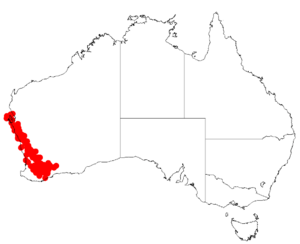Acacia leptospermoides facts for kids
Quick facts for kids Acacia leptospermoides |
|
|---|---|
| Scientific classification | |
| Genus: |
Acacia
|
| Species: |
leptospermoides
|
 |
|
| Occurrence data from AVH | |
Acacia leptospermoides is a type of shrub that belongs to the large group of plants called Acacias. It's special because it only grows in a specific part of south western Australia, which means it is endemic there.
Contents
What Does It Look Like?
This shrub usually grows to be about 0.1 to 2.0 metres (0.3 to 6.6 ft) tall. Its small branches can be smooth (this is called glabrous) or a bit hairy. It has tiny, temporary leaf-like parts called stipules, which are about 2 mm (0.079 in) long.
Leaves and Flowers
Like most Acacia plants, it doesn't have true leaves. Instead, it has flattened leaf-like structures called phyllodes. These phyllodes are grey-green and feel a bit fleshy. They can be long and thin, or more rounded. They are usually 3 to 17 mm (0.12 to 0.67 in) long and 1 to 7 mm (0.039 to 0.276 in) wide. You can see three faint lines (nerves) on the bottom and one on the top.
This plant produces bright yellow flowers from June to September. The flowers grow in simple, round clusters called inflorescences. These clusters are found alone or in pairs where the leaf meets the stem (this spot is called the axil). Each flower cluster is about 4 to 5 mm (0.16 to 0.20 in) across and holds 20 to 35 golden-colored flowers.
Seed Pods
After the flowers bloom, thin, leathery, and smooth seed pods start to form. These pods are long and narrow, and they are slightly squeezed between each seed. They can be curved or even coiled once. The pods grow up to 3 cm (1.2 in) long and are about 1.5 to 2 mm (0.059 to 0.079 in) wide. Inside, you'll find shiny, mottled brown seeds. The seeds are oblong to oval-shaped, about 2.5 to 3 mm (0.098 to 0.118 in) long, and have a small, fleshy attachment called an aril.
How It Was Named
A botanist named George Bentham first officially described this plant in 1855. He wrote about it in a scientific journal called Linnaea. Later, in 2003, another botanist named Leslie Pedley reclassified it. He put it in a different group called Racosperma leptospermoides. But then, in 2006, it was moved back to the Acacia group.
Different Types
There are three slightly different types, or subspecies, of Acacia leptospermoides:
- Acacia leptospermoides subsp. leptospermoides
- Acacia leptospermoides subsp. obovata
- Acacia leptospermoides subsp. psammophila
Where It Grows
Acacia leptospermoides is found in several parts of Western Australia. These areas include the Great Southern, Wheatbelt, and Mid West regions. It often grows on sandy ridges and flat sandy areas. You can find it in soils that are sandy, loamy, or clay-like, especially where there's also gravel or a type of reddish rock called laterite. This plant's home stretches from around Shark Bay in the northwest all the way down to places like Cranbrook and Wagin in the southeast.

